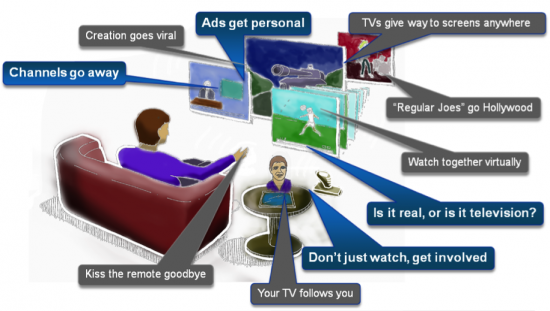 By Leszek Izdebski, Cisco Internet Business Solutions Group (IBSG)
By Leszek Izdebski, Cisco Internet Business Solutions Group (IBSG)
The past few years have brought sweeping transformation to television—a trend that will only accelerate in the coming decade. Following up on a 2011 study on the future of television, Cisco’s Internet Business Solutions Group (IBSG) recently examined the ways disruptive technology and user behavior trends are impacting TV advertising. We identified four major trends that will transform advertising and the viewer experience.
1. Channels Will Go Away
While we do not believe that all future distribution will be through on-demand unicast technologies, consumers will not think about “channels” as the means of accessing programming. Adoption of video on demand, Intelligent Programming Guides and personal video recorders (PVRs) is shifting viewing from linear broadcasts on a TV screen to a multiscreen, multi-device, multi-modal, on-my-schedule, user-controlled experience. Brands and networks will no longer be able to ensure that ads placed in specific episodes will have sufficient audience reach. This behavioral shift will force advertisers to focus on new forms of addressable advertising:
- Ads will be delivered to on-demand viewers in real time or prepositioned on their PVRs, driving the need for addressable ads. Ad buying will increasingly include purchases of specific audience segments across shows, requiring new capabilities for ad delivery and insertion, as well as yield management through analytics.
- Measures and reporting will increasingly need to reflect actual viewing of the ads, as well as brand engagement and impact.
- As product placement continues to play a greater role, campaign design and development activities will need to become even more closely integrated with show development. Branded entertainment, where content is funded by companies seeking to advertise their product, will flourish and the lines between entertainment and infomercials will further blur (e.g. some of today’s reality shows). This will drive the need for higher-quality branded stories.
Figure 1: Four of the Major Changes Coming to Television in the Next Decade Will Directly Impact TV Advertising
Source: Cisco IBSG, 2012
2. Ads Will Get Personal
“Addressability” will evolve from targeting an entire segment with one piece of advertising content to further segmenting the audience and serving differentiated pieces of advertising based on the audience’s characteristics. This personalization will manifest itself in different advertising spots appearing for different users, and in tailored product placement. Not only will one viewer see a different car, in a different color, driven by the show hero—he or she will also hear a different dialogue and possibly see a different scene. To avoid huge additional costs for advertising, creative development, detailed metadata and new rendering approaches will allow partial automated dynamic modifications of video based on the viewer’s segment.
3. Don’t Just Watch, Get Involved
Ad personalization will take many different forms, leading to greater user involvement. Brands will increasingly partner with new types of apps associated with popular TV and movie characters. We will see new forms of marketing where apps currently positioned as extensions to the storyline will provide in-context advice from the show’s characters. For example, through augmented-reality technology on a mobile phone, an app-based representation of a judge from “America’s Next Top Model” will be able to assist in dress selection at a store.
4. Is It Real or Is It Television?
Brands will explore many senses in addition to audio and visual. Tactile feedback technology (haptics), smell, and even taste will be used in TV advertising, supplied through “new remotes” (e.g. game pads, tablets). With the proliferation of 3D printers, we will be able to print a model of a new car, while haptic feedback will allow us to experience driving it on a mountain road. Cosmetic manufacturers will replace those scratch-and-sniff inserts with smell-generating technologies.
Technical & Business Implications
This transformation will require dramatic changes in the entire advertising ecosystem—from creative development, ad buying, and show production, to ad and show delivery mechanisms and device capabilities. The possibilities are thought-provoking and hold the promise of dramatically transforming the TV advertising landscape and redefining the capabilities required to succeed (as well as the players who will dominate). Agencies, media buyers, aggregators and studios need to start today by developing audience-tracking capabilities; better metadata that describes video, scenes, and technical production details; and new analytics to better predict viewership, timing, and demand.
For more information on the future of TV advertising and other transitions in media, please read our Point of View, “The Future of Advertising: Looking Ahead to 2020,” and our original research report, “The Future of Television: Sweeping Change at Breakneck Speed.”


The implicatioms os the technologies you site go beyond well advertising. Brand building can be significantly enhanced as engagement grows.
Good point. Brands in the future will have many more tools at their disposal to promote the brand and to reinforce their specific attributes. So in addition to engagement to make the brand memorable the form of that engagement can focus on specific “after-effects” of that engagement. To leave an impression or feeling that the brand wants its customers to associate with it. It could be “winning a game”, “creating something”, or simply “the amazement of discovery”, etc.